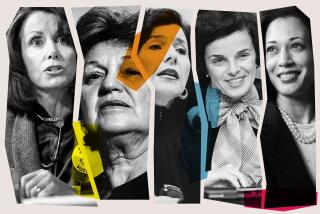The ‘Godmother’ of California’s New Blanket Primary
- Share via
Susan Riegel Harding once taught elementary school pupils about the roots of American democracy. Now she’s about to provide the entire state with a civics lesson.
In the next few months, voters will be introduced to the blanket primary, in which Republicans can vote for Democrats and Democrats for Republicans--or anyone else--and independents can cast ballots in partisan primary contests.
Friends describe the 56-year-old San Diego financial planner as the “godmother” of the new form of primary. So when voters go to their precincts June 2, they can partly thank, or blame, Harding for this sweeping change.
In 1996, the tenacious Harding was part of a cadre of activists who helped engineer one of the year’s big political upsets by first getting Proposition 198--the blanket primary initiative--on the ballot, and then seeing it win big.
Their quest for reform stands out in an era of high-priced political consultants and huge media campaigns. It shows how ordinary, concerned citizens like Harding--albeit with some political connections--can make a crucial difference in state politics.
Harding’s goal was “to create better government” and fewer disagreements among politicians by reducing the election prospects of hard-liners in both parties. “I thought that people were fed up with fighting and all the adversarial stuff” in politics, she said.
Her big break in rounding up backing came early in 1994. She went to the state Capitol office of Tom Campbell, then a Republican state senator from Stanford, to drum up support.
Campbell, a moderate who in 1992 lost a U.S. Senate primary to conservative TV commentator Bruce Herschensohn, lent a sympathetic ear. He agreed to solicit seed money for the initiative from Republican stalwart David Packard, co-founder of Silicon Valley high-tech giant Hewlett-Packard.
As Campbell recalled in an interview, he visited Packard’s Los Altos Hills home hoping to get a modest pledge of $25,000 as he sketched out the need to overhaul the primary balloting.
“And there was a dull thud in the conversation and Mr. Packard looked up at me and said, ‘I’m thinking of supporting this. I’d like to start with $200,000,’ ” Campbell said. “I couldn’t believe my ears.”
Eventually, Packard shelled out $100,000 more, bankrolling nearly one-third of the campaign’s costs. Why was Packard, who died on the day of the 1996 primary, so generous?
“He talked about . . . how he had tried to be a force for moderation and was hopeful this would have that [desired] effect,” said Campbell, now a congressman from the Silicon Valley.
Harding agreed that Packard’s intervention was a turning point for her cause.
The idea of allowing voters a smorgasbord of choices in the primary had germinated before Harding launched her drive, but two previous efforts in the mid-1980s had failed to qualify for the ballot.
Harding said that the blanket primary effort was resurrected after discussions at a 1993 meeting of the California Republican League, a moderate GOP group. Those talks grew out of Campbell’s defeat to Herschensohn. Would Campbell, supporters wondered, have captured the 1992 GOP nomination if there had been an open primary?
Standing in the way were the Republican and Democratic parties, which argued that a blanket primary would produce bland candidates and blur party lines.
“Everyone said it wouldn’t pass, but it did,” said veteran Republican consultant Ron Smith, who helped oversee the signature gathering. Harding, he said, “was the guiding force.”
A native of Brooklyn, Harding said she taught elementary school in Los Angeles from 1966 to 1978. Later, she moved to San Diego, where she was attracted to Republican politics, though she says she was never comfortable with party labels.
An appointee of Gov. Pete Wilson to the state Commission on Aging, Harding said she became frustrated with Republican Party infighting and focused her energy on establishing the new form of primary.
For nearly two years in the mid-1990s, she immersed herself in the project, organizing events and generally shepherding the campaign in a low-key fashion. Of the initiative’s triumph, she said: “Next to raising a daughter, that was probably my biggest achievement.”
Harding’s view is that come June, voters will be surprised by their expanded array of candidate choices and, she believes, more issue-oriented campaigns.
“My hope is that because they [candidates] have to appeal to a broader group . . . they will actually be talking . . . about schools and roads and trade and the things government is supposed to do.”
More to Read
Get the L.A. Times Politics newsletter
Deeply reported insights into legislation, politics and policy from Sacramento, Washington and beyond. In your inbox twice per week.
You may occasionally receive promotional content from the Los Angeles Times.










